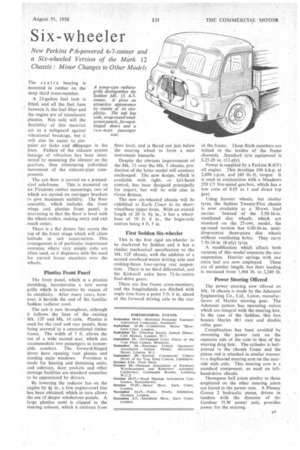Six-wheeler
Page 43

If you've noticed an error in this article please click here to report it so we can fix it.
New Perkins P.6-powered 6-7-totiner and a Six-wheeled Version of the Mark 12 Chassis : Minor Changes to Other Models
The centre bearing is mounted in rubber on the deep third cross-member.
A 23-gallon fuel tank is fitted, and all the fuel lines between it, the fuel filter and the engine are of translucent plastics. Not only will the flexibility of this material act as a safeguard against vibrational breakage, but it will also be easier to pinpoint air leaks and stbppages in the Failure of the exhaust system becau§e of vibration has been minimized by mounting the silencer on the gearbox, thus eliminating individual movement of the exhaust-pipe components.
The cab floor is carried on a pressedsteel sub-frame. This is mounted on six Firestone rubber mountings, two of which are carried on outrigger brackets to give maximum stability. The floor assembly, which includes the front wings and plastics front panel, is interesting in that the floor is level with the wheel-arches, making entry and exit much easier.
There is a flat datum line across the top of the front wings which will allow latitude in cab construction. This arrangement is of particular importance overseas, where very simple cabs arc often used, as it dispenses with the need for curved frame members over the wheels.
Plastics Front Panel The front panel, which is a plastics moulding, incorporates a new scoop grille which is attractive by reason of its simplicity. After many years, however, it heralds the end of the familiar Seddon radiator cowl.
The cab is new throughout, although it follows the lines of the existing Mk. 12F and Mk. 14 cabs. Plastics is used for the roof and rear panels, these being screwed to a conventional timber frame. The width of 7 ft. allows the use of a wide second seat, which can accommodate two passengers in reasonable comfort. The forward-hinged doors have opening vent glasses and winding main windows. Provision is made for heating and demisting units, and ashtrays, door pockets and other stowage facilities are standard amenities to be appreciated by drivers.
By lowering the radiator fan on the engine by 41 in., a low engine-cowl line has been obtained, which in turn allows the use of deeper windsm-een panels. A large plastics cowl is clipped to the steering column, which it encloses from
floor level, and is flared out just below the steering wheel to form a neat instrument binnacle.
Despite the obvious improvement of the Mk. 15 over the Mk. 5 chassis, production of the latter model will continue unchanged. The new design, which is available with right-. or left-hand control, has been designed principally for export,but will be sold also in Great Britain,
The new six-wheeled chassis will be exhibited at Earls Court in its shortwheelbase tipper form. With an overall length of 20 ft. 84 in., it has a wheelbase of 10 ft. 8 in., the bogie-axle centres being 4 ft. 5 in.
First Seddon Six-wheeler
This is the first rigid six-wheeler to be marketed by Seddon and it has a similar mechanical specification to the Mk. 12F chassis, with the addition of a second overhead-worm driving axle and rocking-beam four-spring rear suspension. There is no third difIerential, and the Kirkstall axles have 74-in.-centre final-drive gears.
There are five frame cross-members, and the lorigitudinals are filched with angle iron from a point 3 ft. 6 in. ahead of the forward driving axle to the rear of the frame. These flitch members are bolted to the insides of the frame channels. Standard tyre equipment is 8,25-20 in, (12-ply).
Power is supplied by a Perkins R.6(V) oil engine. This develops 104 b.h.p. at 2,400 r.p.m. and 240 lb.-ft. torque. It is used in conjunction with a Meadows 250 C5 five-speed gearbox, which has a low ratio of 8.05 to 1 and direct top gear.
Using heavier wheels, but similar tyres, the Seddon Twenty-Five chassis is now available as a 30-cwt. load carrier. Instead of the 5.50-16-in. ventilated disc wheels, which are standard on the 25-cwt. model, the up-rated version has 6.00-16-in, semidrop-centre three-piece disc wheels without ventilating holes. They carry 7.50-16-in. (8-ply) tyres.
A modification which affects both versions of this model concerns the rear suspension. Heavier springs with one extra leaf are now employed. These are of similar length, but their. loading is increased from 1,904 lb. to 2,240 lb.
Power Steering Offered The power steering now offered on Mk. 14 chassis is made by the Adamant &ngineering Co.. Ltd., Luton, manufacturers of Marks steering gear. •The Adamant system has operating -valves which are integral with the steering box. In the case of the Seddon, this box houses Marles 861 cam and double roller gear.
Complication has been avoided by mounting the power ram on the opposite side of the axle to that of the steering drag link. The cylinder is balljointed to the chassis frame and the piston rod is attached in similar manner to a duplicated steering arm on the nearside stub axle. This steering arm is a standard component, as used on lefthand-drive chassis.
Thompson ball joints similar to those employed on the other steering joints are found in the power ram. A Plessey Group 2 hydraulic pump, driven in tandem with the dynamo of the Gardner 5LW power unit, provides power for the steering.




































































































